Abstract
Pancreatic cancer is one of the most lethal cancers in humans. The majority of these cancers arise from the pancreatic duct epithelium. Research into the pathogenesis of pancreatic carcinoma has largely relied on animal models. In vitro models of pancreatic carcinogenesis using propagable cultured epithelial cells derived from the pancreatic ducts of rats and hamsters have been described. A human model, however, has been nonexistent due to the unavailability of propagable cultured duct epithelial cells derived from normal human pancreas. We report here a reproducible method for the long-term culture of pancreatic duct epithelial cells derived from normal and benign adult human pancreata by infection with a retrovirus containing the E6 and E7 genes of the human papilloma virus 16. One of these cell lines has become immortal and has propagated continuously for more than 20 passages. They remain anchorage dependent in their growth and nontumorigenic in nude mice. These cell lines and the methodology described here to establish them may provide new avenues for in vitro studies of the roles played by duct epithelium in human pancreatic diseases and cancers.
Full text
PDF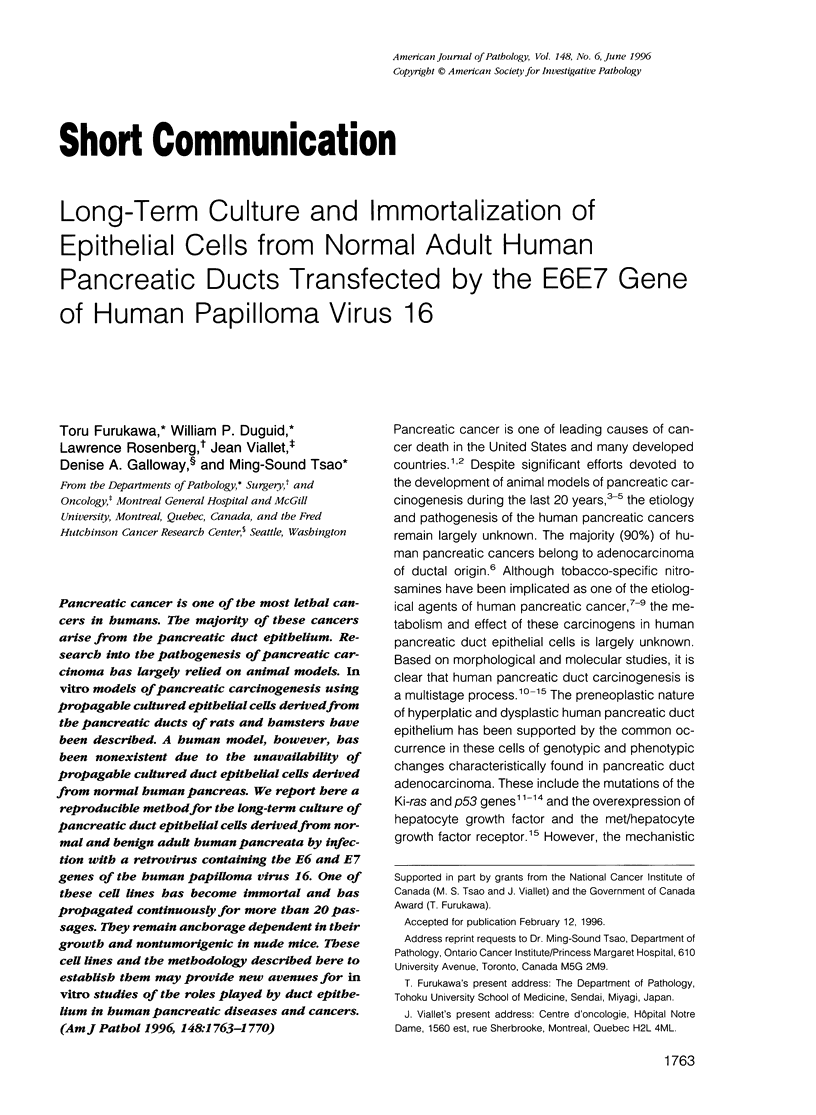
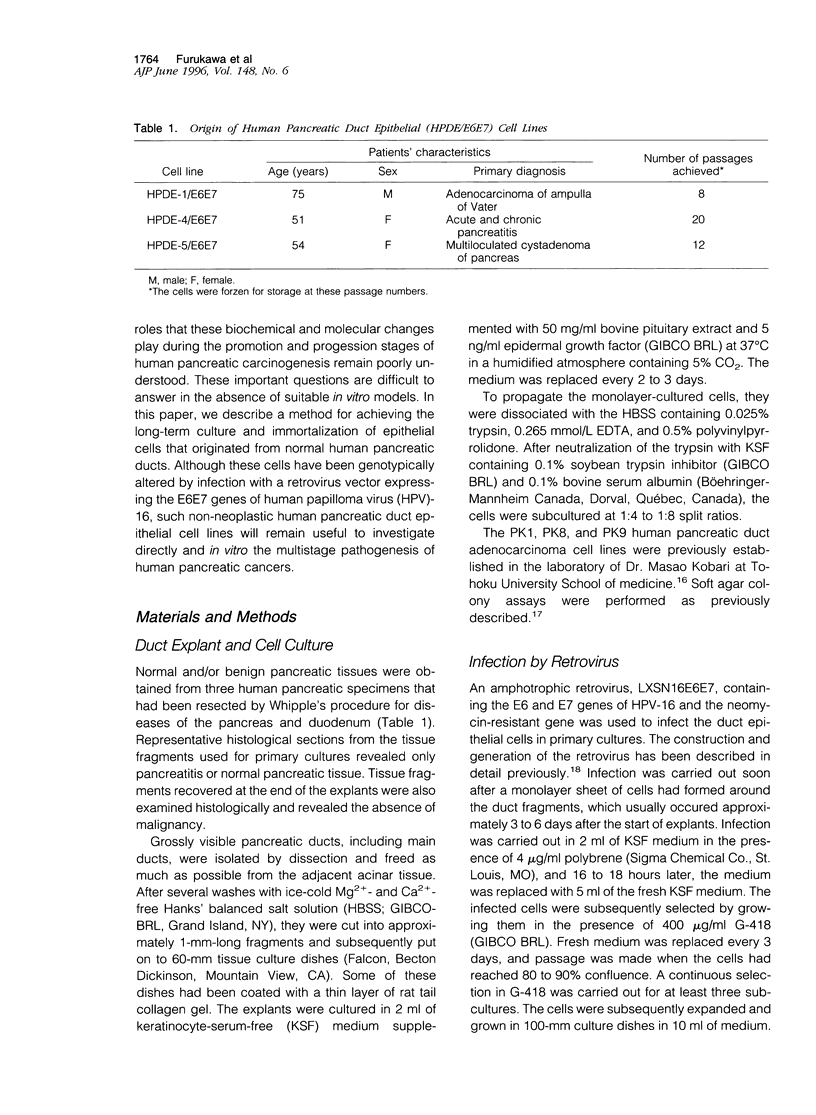
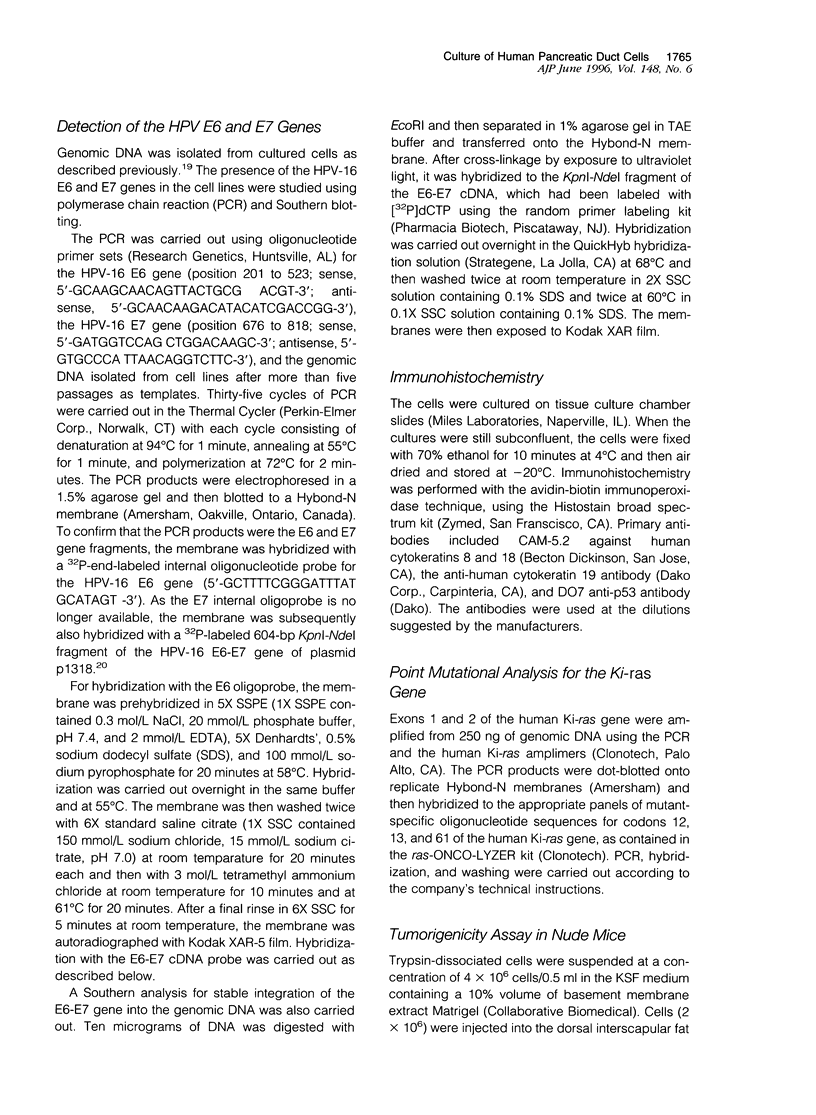
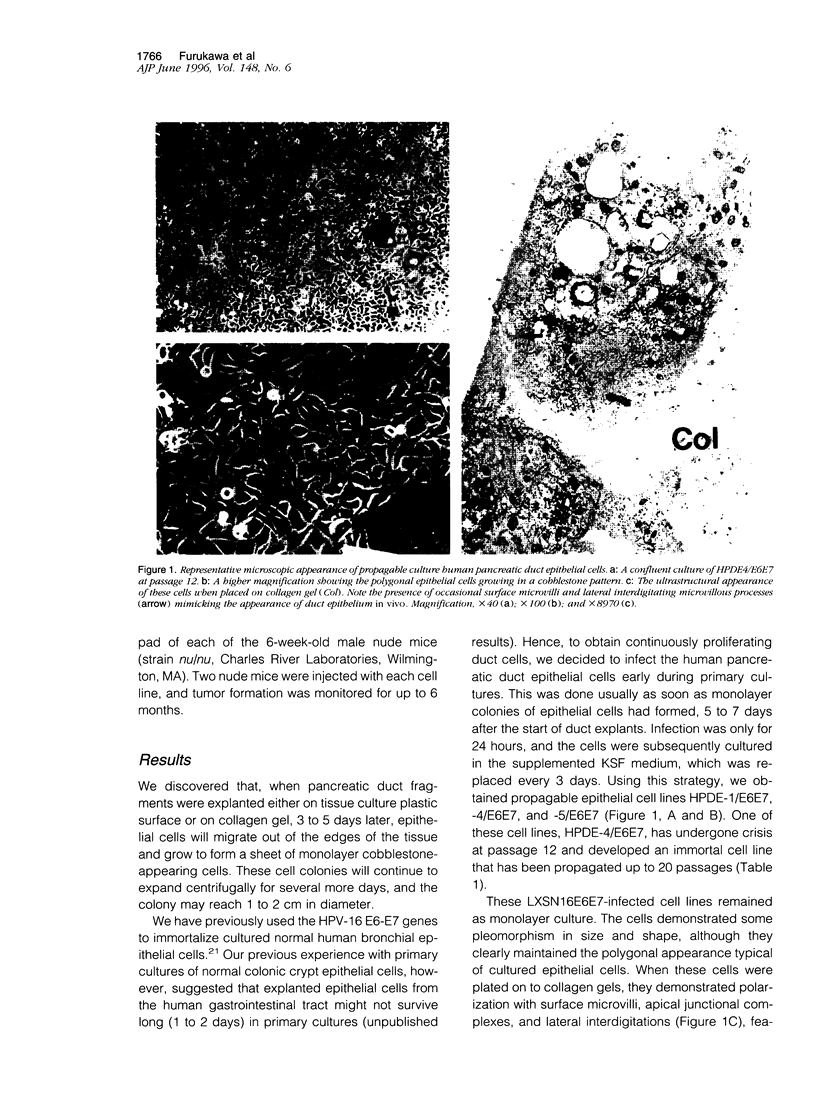
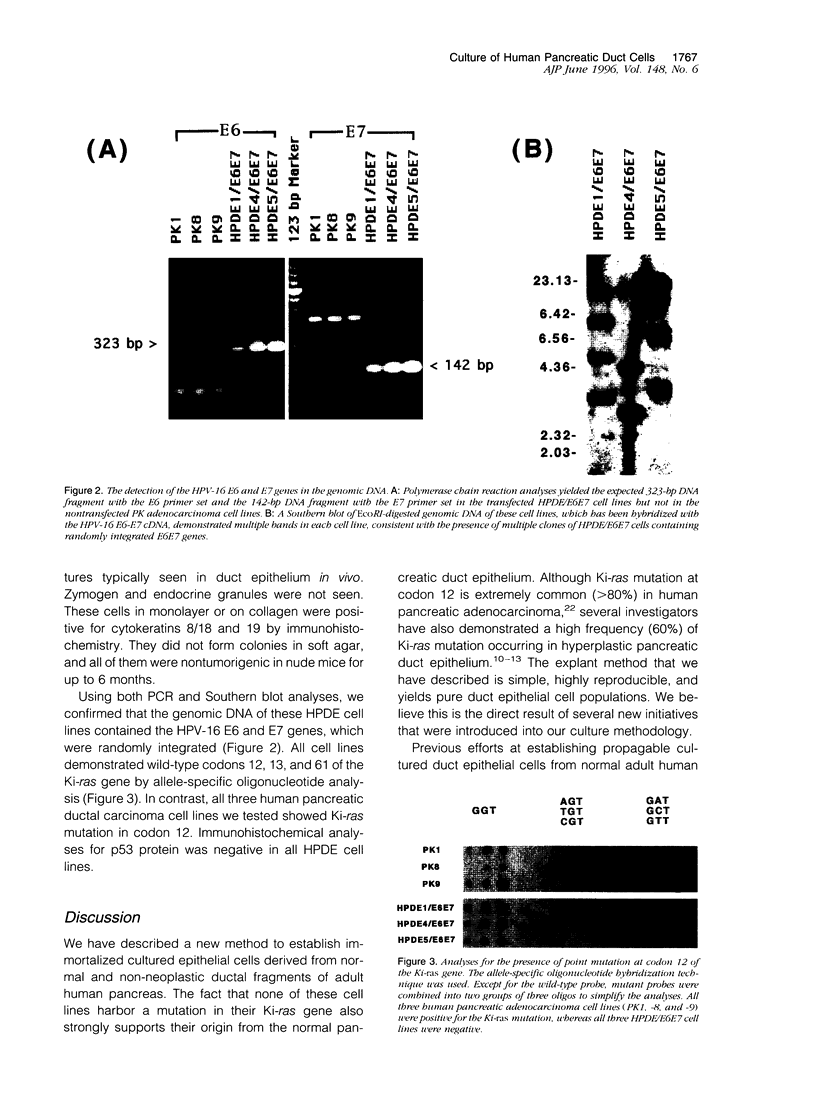
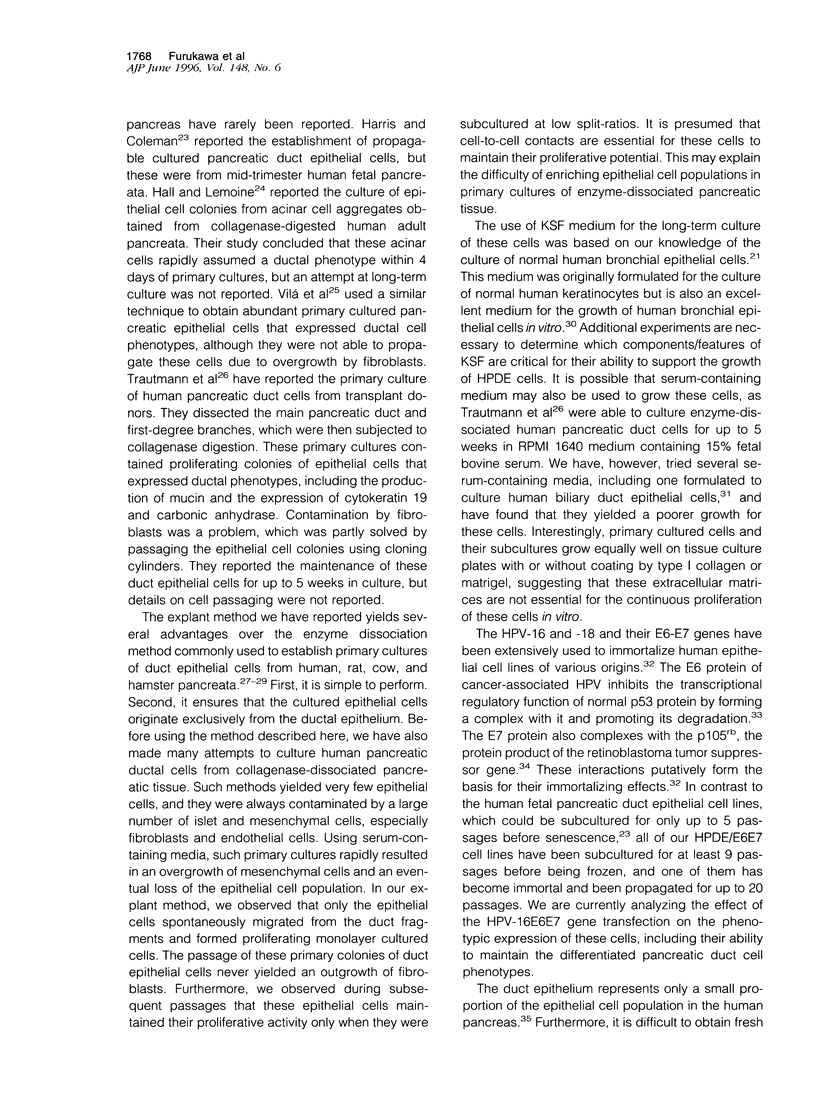

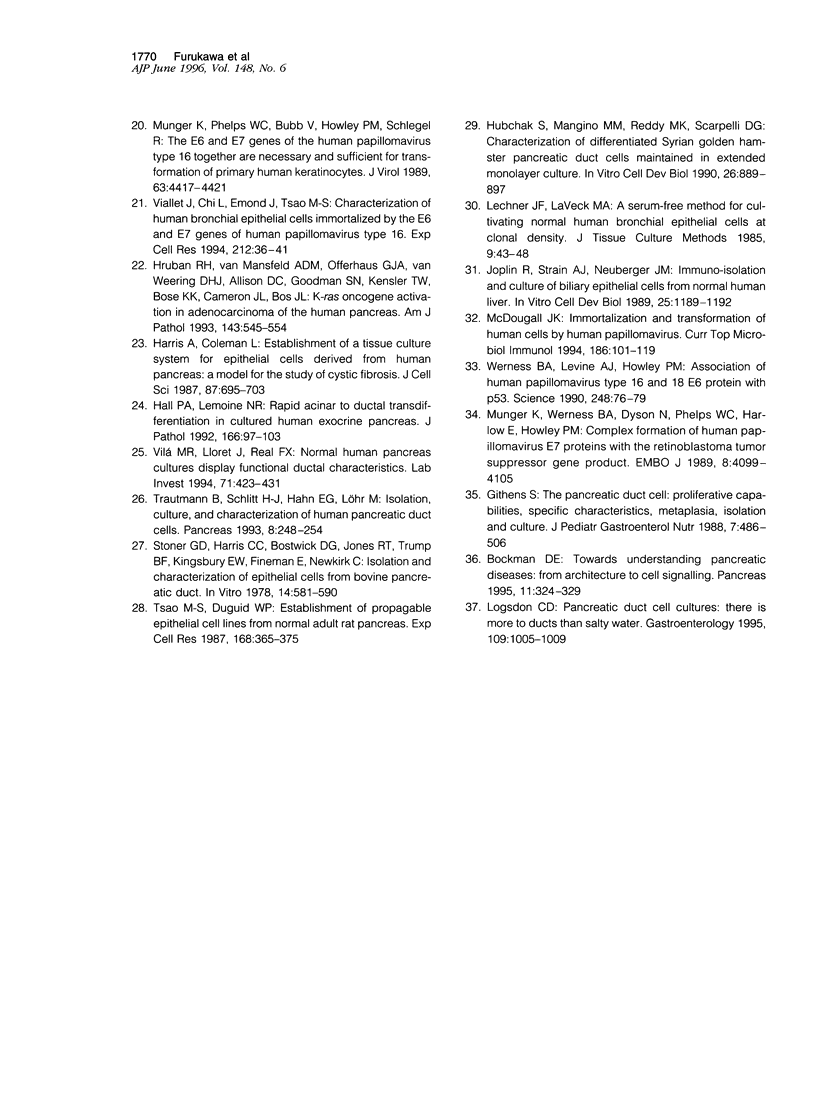
Images in this article
Selected References
These references are in PubMed. This may not be the complete list of references from this article.
- Bockman D. E. Toward understanding pancreatic disease: from architecture to cell signaling. Pancreas. 1995 Nov;11(4):324–329. doi: 10.1097/00006676-199511000-00002. [DOI] [PubMed] [Google Scholar]
- Boschman C. R., Stryker S., Reddy J. K., Rao M. S. Expression of p53 protein in precursor lesions and adenocarcinoma of human pancreas. Am J Pathol. 1994 Dec;145(6):1291–1295. [PMC free article] [PubMed] [Google Scholar]
- Caldas C., Hahn S. A., Hruban R. H., Redston M. S., Yeo C. J., Kern S. E. Detection of K-ras mutations in the stool of patients with pancreatic adenocarcinoma and pancreatic ductal hyperplasia. Cancer Res. 1994 Jul 1;54(13):3568–3573. [PubMed] [Google Scholar]
- Furukawa T., Chiba R., Kobari M., Matsuno S., Nagura H., Takahashi T. Varying grades of epithelial atypia in the pancreatic ducts of humans. Classification based on morphometry and multivariate analysis and correlated with positive reactions of carcinoembryonic antigen. Arch Pathol Lab Med. 1994 Mar;118(3):227–234. [PubMed] [Google Scholar]
- Furukawa T., Duguid W. P., Kobari M., Matsuno S., Tsao M. S. Hepatocyte growth factor and Met receptor expression in human pancreatic carcinogenesis. Am J Pathol. 1995 Oct;147(4):889–895. [PMC free article] [PubMed] [Google Scholar]
- Githens S. The pancreatic duct cell: proliferative capabilities, specific characteristics, metaplasia, isolation, and culture. J Pediatr Gastroenterol Nutr. 1988 Jul-Aug;7(4):486–506. [PubMed] [Google Scholar]
- Halbert C. L., Demers G. W., Galloway D. A. The E7 gene of human papillomavirus type 16 is sufficient for immortalization of human epithelial cells. J Virol. 1991 Jan;65(1):473–478. doi: 10.1128/jvi.65.1.473-478.1991. [DOI] [PMC free article] [PubMed] [Google Scholar]
- Hall P. A., Lemoine N. R. Rapid acinar to ductal transdifferentiation in cultured human exocrine pancreas. J Pathol. 1992 Feb;166(2):97–103. doi: 10.1002/path.1711660203. [DOI] [PubMed] [Google Scholar]
- Harris A., Coleman L. Establishment of a tissue culture system for epithelial cells derived from human pancreas: a model for the study of cystic fibrosis. J Cell Sci. 1987 Jun;87(Pt 5):695–703. doi: 10.1242/jcs.87.5.695. [DOI] [PubMed] [Google Scholar]
- Hruban R. H., van Mansfeld A. D., Offerhaus G. J., van Weering D. H., Allison D. C., Goodman S. N., Kensler T. W., Bose K. K., Cameron J. L., Bos J. L. K-ras oncogene activation in adenocarcinoma of the human pancreas. A study of 82 carcinomas using a combination of mutant-enriched polymerase chain reaction analysis and allele-specific oligonucleotide hybridization. Am J Pathol. 1993 Aug;143(2):545–554. [PMC free article] [PubMed] [Google Scholar]
- Hubchak S., Mangino M. M., Reddy M. K., Scarpelli D. G. Characterization of differentiated Syrian golden hamster pancreatic duct cells maintained in extended monolayer culture. In Vitro Cell Dev Biol. 1990 Sep;26(9):889–897. doi: 10.1007/BF02624614. [DOI] [PubMed] [Google Scholar]
- Joplin R., Strain A. J., Neuberger J. M. Immuno-isolation and culture of biliary epithelial cells from normal human liver. In Vitro Cell Dev Biol. 1989 Dec;25(12):1189–1192. doi: 10.1007/BF02621273. [DOI] [PubMed] [Google Scholar]
- Kobari M., Matsuno S., Sato T., Kan M., Tachibana T. Establishment of a human pancreatic cancer cell line and detection of pancreatic cancer associated antigen. Tohoku J Exp Med. 1984 May;143(1):33–46. doi: 10.1620/tjem.143.33. [DOI] [PubMed] [Google Scholar]
- Liu C., Tsao M. S. Proto-oncogene and growth factor/receptor expression in the establishment of primary human non-small cell lung carcinoma cell lines. Am J Pathol. 1993 Feb;142(2):413–423. [PMC free article] [PubMed] [Google Scholar]
- Logsdon C. D. Pancreatic duct cell cultures: there is more to ducts than salty water. Gastroenterology. 1995 Sep;109(3):1005–1009. doi: 10.1016/0016-5085(95)90415-8. [DOI] [PubMed] [Google Scholar]
- McDougall J. K. Immortalization and transformation of human cells by human papillomavirus. Curr Top Microbiol Immunol. 1994;186:101–119. doi: 10.1007/978-3-642-78487-3_6. [DOI] [PubMed] [Google Scholar]
- Münger K., Phelps W. C., Bubb V., Howley P. M., Schlegel R. The E6 and E7 genes of the human papillomavirus type 16 together are necessary and sufficient for transformation of primary human keratinocytes. J Virol. 1989 Oct;63(10):4417–4421. doi: 10.1128/jvi.63.10.4417-4421.1989. [DOI] [PMC free article] [PubMed] [Google Scholar]
- Münger K., Werness B. A., Dyson N., Phelps W. C., Harlow E., Howley P. M. Complex formation of human papillomavirus E7 proteins with the retinoblastoma tumor suppressor gene product. EMBO J. 1989 Dec 20;8(13):4099–4105. doi: 10.1002/j.1460-2075.1989.tb08594.x. [DOI] [PMC free article] [PubMed] [Google Scholar]
- Pour P. M., Sayed S., Sayed G. Hyperplastic, preneoplastic and neoplastic lesions found in 83 human pancreases. Am J Clin Pathol. 1982 Feb;77(2):137–152. doi: 10.1093/ajcp/77.2.137. [DOI] [PubMed] [Google Scholar]
- Reddy J. K., Rao M. S. Progress in pancreatic cancer: implications of phenotypic and molecular plasticity. Lab Invest. 1995 Apr;72(4):383–386. [PubMed] [Google Scholar]
- Scarpelli D. G., Rao M. S., Reddy J. K. Studies of pancreatic carcinogenesis in different animal models. Environ Health Perspect. 1984 Jun;56:219–227. [PMC free article] [PubMed] [Google Scholar]
- Stoner G. D., Harris C. C., Bostwick D. G., Jones R. T., Trump B. F., Kingsbury E. W., Fineman E., Newkirk C. Isolation and characterization of epithelial cells from bovine pancreatic duct. In Vitro. 1978 Jul;14(7):581–590. doi: 10.1007/BF02617917. [DOI] [PubMed] [Google Scholar]
- Tada M., Omata M., Ohto M. Ras gene mutations in intraductal papillary neoplasms of the pancreas. Analysis in five cases. Cancer. 1991 Feb 1;67(3):634–637. doi: 10.1002/1097-0142(19910201)67:3<634::aid-cncr2820670318>3.0.co;2-7. [DOI] [PubMed] [Google Scholar]
- Trautmann B., Schlitt H. J., Hahn E. G., Löhr M. Isolation, culture, and characterization of human pancreatic duct cells. Pancreas. 1993 Mar;8(2):248–254. doi: 10.1097/00006676-199303000-00017. [DOI] [PubMed] [Google Scholar]
- Tsao M. S., Duguid W. P. Establishment of propagable epithelial cell lines from normal adult rat pancreas. Exp Cell Res. 1987 Feb;168(2):365–375. doi: 10.1016/0014-4827(87)90009-7. [DOI] [PubMed] [Google Scholar]
- Tsao M. S., Munzer J. S., Lee D., Phillips N. C. The comparative effects of tumor necrosis factor on tumor cells growing anchorage dependently and independently. J Biol Response Mod. 1989 Jun;8(3):297–304. [PubMed] [Google Scholar]
- Viallet J., Liu C., Emond J., Tsao M. S. Characterization of human bronchial epithelial cells immortalized by the E6 and E7 genes of human papillomavirus type 16. Exp Cell Res. 1994 May;212(1):36–41. doi: 10.1006/excr.1994.1115. [DOI] [PubMed] [Google Scholar]
- Vila M. R., Lloreta J., Real F. X. Normal human pancreas cultures display functional ductal characteristics. Lab Invest. 1994 Sep;71(3):423–431. [PubMed] [Google Scholar]
- Warshaw A. L., Fernández-del Castillo C. Pancreatic carcinoma. N Engl J Med. 1992 Feb 13;326(7):455–465. doi: 10.1056/NEJM199202133260706. [DOI] [PubMed] [Google Scholar]
- Werness B. A., Levine A. J., Howley P. M. Association of human papillomavirus types 16 and 18 E6 proteins with p53. Science. 1990 Apr 6;248(4951):76–79. doi: 10.1126/science.2157286. [DOI] [PubMed] [Google Scholar]
- Wingo P. A., Tong T., Bolden S. Cancer statistics, 1995. CA Cancer J Clin. 1995 Jan-Feb;45(1):8–30. doi: 10.3322/canjclin.45.1.8. [DOI] [PubMed] [Google Scholar]
- Yanagisawa A., Ohtake K., Ohashi K., Hori M., Kitagawa T., Sugano H., Kato Y. Frequent c-Ki-ras oncogene activation in mucous cell hyperplasias of pancreas suffering from chronic inflammation. Cancer Res. 1993 Mar 1;53(5):953–956. [PubMed] [Google Scholar]





